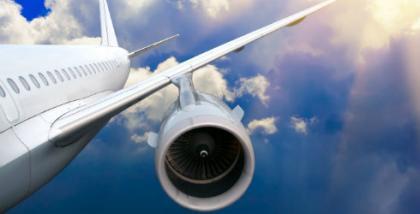Everything You Ever Wanted to Know About Flying (But Were Afraid To Ask)
LT Globetrotter
Some people fly so often that they can navigate gate changes and security lines with their eyes closed. But if you’re new to flying, or taking your first international trip, consider this your guide to everything air.
Got a question? We've got the answer. From customs forms to checking luggage, this is your ultimate guide to flights.
What do I need?
Make sure you have valid ID. If you’re flying internationally you’ll need to have a passport, and some countries require that you also have an entry visa. Depending on where you’re going, visas can be a little tricky to apply for and receive, so make sure you check what the requirements are well in advance of your trip.
When should I get to the airport?
The general rule of thumb is three hours before your scheduled departure time for international flights, and two hours for domestic flights. Take into consideration things like whether you're checking any luggage, if you've already checked in, or if you're travelling during a busy holiday weekend where security lines may be extra long - you may want to push your time up or back depending.
What do I do when I get to the airport?
After you buy a ticket, you’ll be sent an email confirmation from your travel consultant with all the details on your flight. You can use your airline confirmation number to check in from 24 hours prior to the flight for most carriers. Once you check in you’ll normally have the option to select or change your seat, add baggage, and print or email yourself a copy of your boarding pass to show officials when you arrive at the airport. Some airlines even have smartphone apps that will have your boarding pass and flight information.
If you’ve checked in before your flight and don’t need to check any luggage, you can head straight to security when you arrive at the airport. Otherwise, you’ll need a gate agent or electronic kiosk to check you in, drop off any checked luggage, and print out a copy of your boarding pass. Check-in desks are normally right inside the airport’s Departures entrance, and are clearly labeled according to airline.
After you’re checked in, have your boarding pass, and have checked any luggage that you’re not carrying on with you, you can head through security.
What’s the process for going through security?
When you get to the security area, an agent will check your ID and boarding pass as you get in line. You’ll place your luggage on the conveyor belt to be screened, along with any purse or personal items you may be carrying, and will need to take off your shoes, jacket, and belt (keep in mind that laptop or tablet will need to be removed and scanned separately). If there are any issues, agents will ask you to open your bag so they can take a closer look.
You’ll also need to be scanned as well. Specific security features vary from airport to airport – some will make you pass through either a metal detector, and others will have you step into a full-body scanner. You can opt out of going through a machine if you want, but you’ll still need to be patted down by a security agent.
What can and can’t I take on the plane?
A good rule of thumb is that if you think it’s banned, it probably is. Also not allowed are any liquids over 3 ounces, so make sure you check, empty, or dispose of any liquid over this size (including water bottles and drinks - sorry) before getting in line.
What happens after I pass through security?
Your boarding pass will list your flight number and the gate you’ll be leaving from. You can also check one of the departure screens for updated information about any gate changes or flight delays. Feel free to explore the airport or grab a bite to eat if you’re early, but make sure that you’re back at your gate by boarding time.
What’s the difference between boarding and takeoff times?
Your boarding time is when the airline will start calling people to board the plane, and your takeoff time is when the plane will actually pull away from the gate and onto the runway. It’s important to make sure that you’re at your gate by your boarding time – if you’re late, there’s a good chance that the gate will already be closed, even if it’s not time for takeoff yet.
How does boarding work?
You gate agent will announce on the loudspeaker that you're boarding, and will begin to call people up in groups. Normally they’ll call for first class, people with small children, or people needing assistance before they start to board the rest of the plane. Boarding is usually determined by what row you’re sitting in, so make sure you know your seat number. When you’re called to board, you’ll hand the agent your boarding pass and head into the plane to find your seat.
What will happen on the flight?
After you find your seat, you can store any luggage that you may have in the overhead compartment or under the seat in front of you. If you are in the bulkhead (a row with a wall or partition in front of it, like the one separating first class and coach), you’ll need to store all your items overhead. After everyone takes their seats, your flight attendants will go through safety instructions with you and ask everyone to put on their seatbelts, store any loose items under the seat in front of them, and turn off large electronics such as laptops and tablets until the plane has taken off. In the US, many carriers allow usage of your cellular phone from gate to gate in airplane mode. Check with your carrier for more details.
Once you get high enough, you’ll be able to turn back on your electronics and walk around the cabin. Flights normally offer drinks like water, soda, and coffee onboard, but they may not have any food available – even on what you think may be a longer flight. Be sure to bring something with you if you think you’re going to be hungry.
If you’re flying internationally, you’ll usually be handed a form for to fill out and hand in to customs and immigrations when you land.
Where do I go when I land?
If you checked your luggage, you can follow signs for baggage claim to pick up your bags.
If you’re flying internationally, you’ll also need to clear customs and immigration with the completed form you filled out on the plane. Some countries also require you to pay an entrance fee or fill out an arrival/departure card.
Lastly, be sure to contact your travel consultant with any questions you might have – they’re the ones that can help you out of a jam if there’s a delay or weather problem or anything. Happy flying!
















